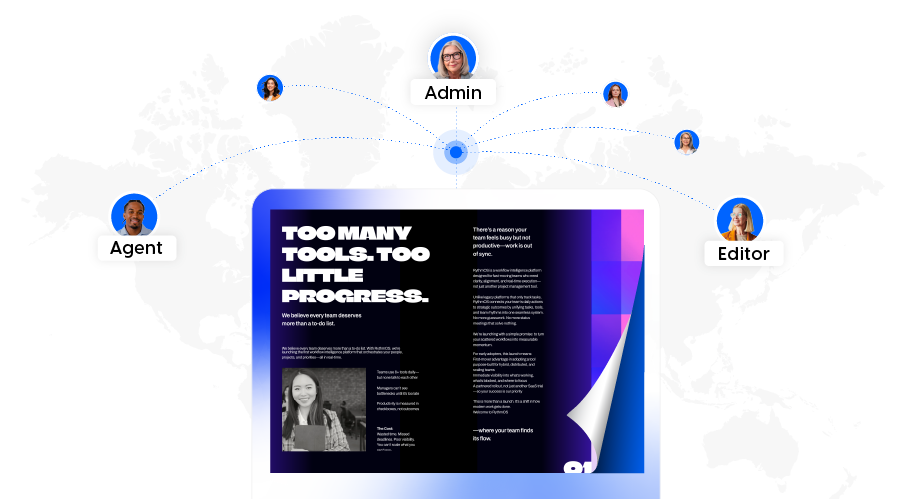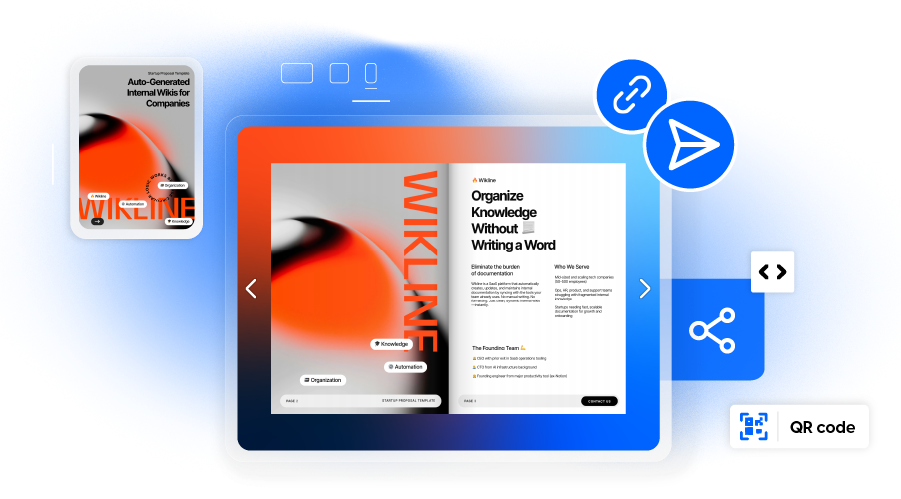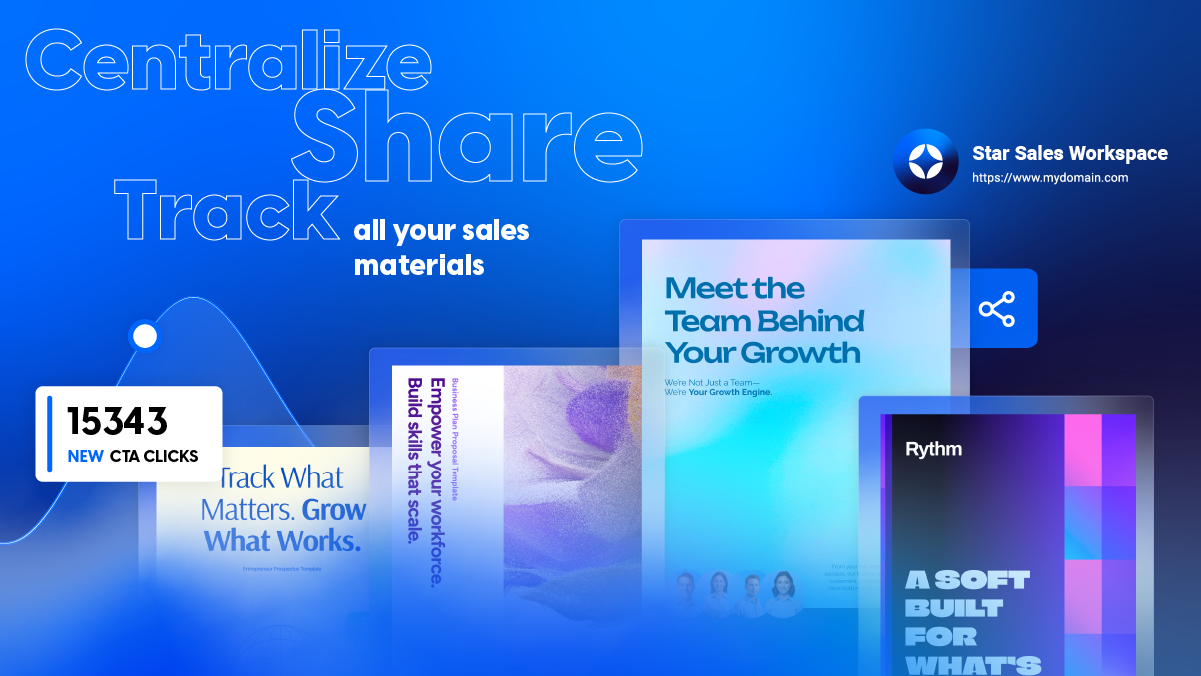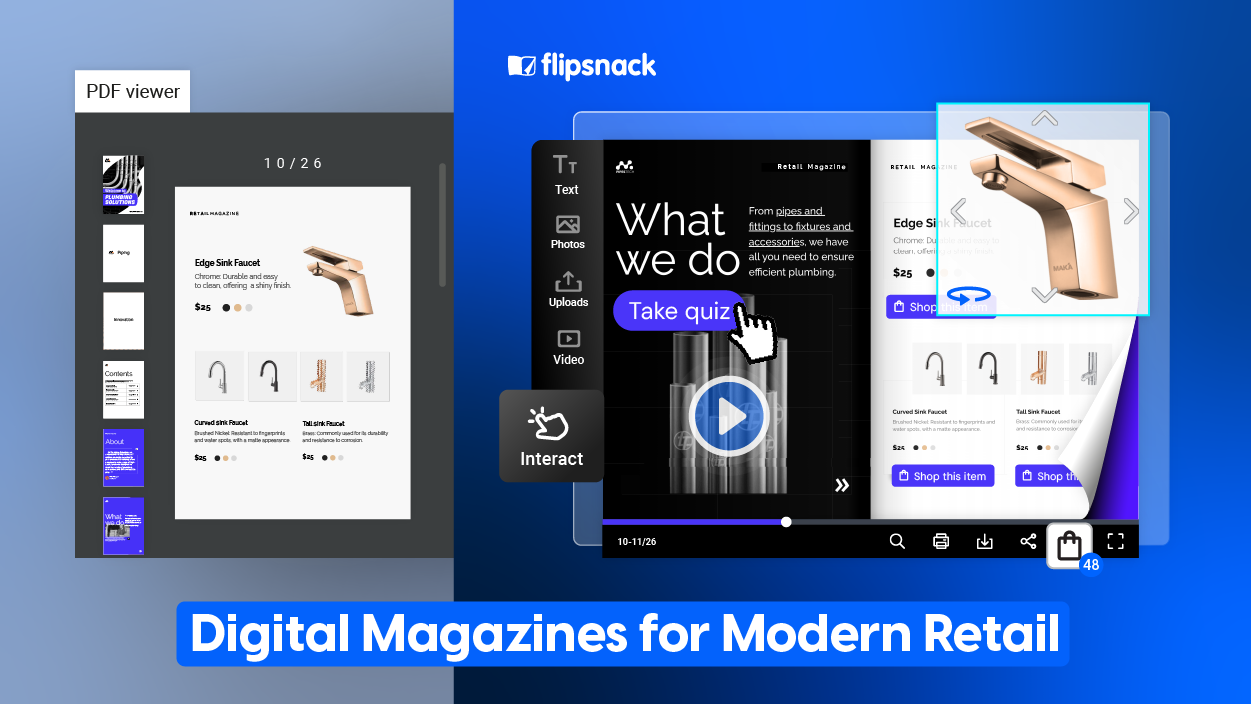How Flipsnack Helps Sales Teams Create, Share, and Track Winning Materials
Your sales team spends hours creating presentations, catalogs, and one-pagers. You send them out as PDFs and then you have no idea if they were opened, read, or ignored.
When updates are needed, the process starts all over again. Different teams make their own versions, and brand consistency slips.
This is how opportunities are lost. Without engagement, without data, and without one sales enablement platform for all sales materials, it is impossible to know what works and what doesn’t.
You can change all that by using the right platform and turning static PDF files into interactive, trackable flipbooks your team can update and share in minutes.
If you’re leading a B2B sales team or looking for ways to improve how your reps create, share, and track sales content, this article will show you how Flipsnack works as a complete sales enablement platform.
Why traditional PDFs can’t keep up with sales needs
Creating sales materials in PowerPoint or InDesign is a good start. You get a polished design and a professional look. But once that work is saved as a PDF, the magic stops.
A PDF is static. It cannot respond to your reader. It cannot guide them through your story. It is a one-way street where you send information out and hope something happens.
And the thing is, you end up with:
Ineffective materials
PDFs may look fine, but they lack movement, interactivity, and the ability to truly hold attention. In a world where your prospects are bombarded with content, static pages often get skimmed or ignored.
Lack of data
Once a PDF is sent, you are left in the dark. You do not know if it was opened, how long it was read, or which parts made an impact. This is a lost opportunity to understand what content resonates and to focus your follow-up on the most engaged leads.
Siloed work and inconsistent branding
When different teams create and store their own materials, content gets duplicated, designs vary, and outdated versions slip through. The result is a cluttered asset library and a brand that feels inconsistent to your audience.
Switching from static PDFs to a dynamic format (flipbook) changes all of this. It opens the door to interactivity, real-time insights, and a single source of truth for your sales content.

Introducing Flipsnack: the unified sales enablement platform your team needs
Flipsnack is not just another design tool. It is the unified platform for document management and sales enablement that brings every stage of your content workflow into one place.
With Flipsnack, you can turn a static PDF into an interactive flipbook enriched with videos, links, forms, and animations. You can also start from a template or from scratch and build new materials directly on the platform. Either way, your sales content becomes engaging, trackable, and always up to date.
From creating professional sales materials to hosting, sharing them securely and tracking every interaction, Flipsnack allows sales teams to manage it all without switching between tools or juggling multiple file versions.
It combines the flexibility of a content editor, the reach of digital publishing, and the precision of analytics in one seamless experience.
Here’s what I mean when I say unified platform:
1. Professional and engaging content
First of all, you can easily replace static PDFs with digital flipbooks that feel alive.
Using Flipsnack’s intuitive drag-and-drop Design Studio, your team can add interactive elements like videos, insert clickable links, add forms to capture leads, and use subtle animations to guide the reader through your story.
The result is content that looks and feels premium, complete with a realistic page-turning effect that holds attention longer and leaves a stronger impression.
2. A central hub for team collaboration

One of the biggest challenges for sales teams is keeping everyone aligned. Materials are often scattered across personal folders, emails, and outdated shared drives.
A sales enablement tool eliminates this problem by acting as the single source of truth for all your sales content.
There are different role permissions in Flipsnack, and if you’re the Owner, you can assign these access levels when sharing your flipbook:
- Admins have the same control as the owner, with full access to manage flipbooks, settings, and the entire account.
- Editors can create and edit any flipbook but can’t access Billing or account Settings.
- Agents work only on their own flipbooks and don’t have access to Billing or Settings.
- Contributors can create, edit, and view their own flipbooks, but only an Owner, Admin, or Editor can publish them.
For example, a wholesaler might give Editors access to design and update product catalogs, while Agents in different regions create their own localized versions. Contributors could prepare drafts of seasonal guides, leaving the final publishing to an Admin or Owner who ensures everything is consistent and ready to share.
With permissions tailored to each role, companies can collaborate across teams without risking brand consistency, data security, or version chaos. It makes the entire process of producing and distributing buyer’s guides smoother and more reliable.
3. Locked templates for brand consistency
Besides role permissions, you can also have locked templates, which let you create branded frameworks that everyone in your team can follow.
By fixing the position, size, and style of key elements like logos and text boxes, you prevent unauthorized edits and keep every design perfectly aligned with your brand guidelines.
This means no stretched logos, off-brand colors, or misplaced visuals, even when multiple teammates are working on localized versions for different regions.
Once saved, locked templates can be reused for future projects, speeding up production while ensuring every publication stays consistent and on-brand.
4. Insightful analytics and data-driven sales
In sales, knowing how a prospect engages with your materials can make the difference between closing a deal and losing it.
Flipsnack’s built-in analytics show you exactly what happens after you hit “send.” You can see how many times a flipbook was opened, which pages were viewed, how long each page held attention, and which links were clicked.
Trackable links give you even more precision, showing exactly who opened the document and for how long.
These insights can be integrated with your existing sales and marketing tools, helping your team prioritize high-interest leads and tailor follow-up conversations based on real behavior rather than guesswork.
5. Easy access and instant updates

It wouldn’t be a sales enablement solution without you being able to access your sales materials anytime and anywhere.
Everything you make in Flipsnack works seamlessly on mobile, tablet, and desktop. This means your sales team can present a catalog in a meeting room, share a one-pager with a prospect at an event, or send a proposal from home without missing a beat.
Whenever you need to make changes, the update is instant. If you adjust a price, swap out an image, or rewrite a section in Flipsnack, the new version automatically appears everywhere the flipbook is shared. You never have to resend files or worry about someone reading an outdated document.
6. Integrations that fit your sales workflow
A B2B sales enablement tool needs to work with the systems you already use, not force you to rebuild your processes from scratch. Flipsnack integrates with CRMs, DAMs, and authentication systems like SSO, so your sales materials connect seamlessly to your existing tech stack.
For sales teams, this matters in two key ways:
Secure access with SSO
With Single Sign-On, your reps never waste time juggling passwords or requesting access. An entire sales team can log in instantly with their company credentials and have secure access to the flipbooks they need. You can even extend SSO to prospects and partners so when you share a private proposal, they log in securely through your system without extra accounts. That means less friction, stronger data security, and faster deal cycles.
Think about trade shows, where reps have only a few minutes with each prospect. With offline access and SSO-enabled sharing, every rep could instantly open the right brochure, present it confidently, and send a secure link to the customer afterward.
Embedding and automation
Through API connections and automation tools, sales teams can embed interactive flipbooks directly into websites, sales portals, or distributor platforms. This way, buyer’s guides, catalogs, and one-pagers are always available in the same places where prospects and partners already interact with your brand.
Flipbooks can also include contact forms for lead capture. A prospect browsing your catalog on the website, or a customer reviewing a flipbook shared by a rep, can submit their details right inside the document. That information can then be exported or connected to your CRM, giving sales managers clear visibility into who engaged and what they are interested in.
Customer spotlight: How Radioshuttle® closed major deals using interactive product brochures
Radioshuttle®, a leader in automated pallet handling systems, needed a better way to engage prospects, simplify content sharing, and support their global sales team.
Long, static PowerPoint presentations were losing attention, large files were hard to share, and training materials were scattered.
By switching to Flipsnack, they created an interactive digital brochure that became their central sales and training tool — complete with videos, case studies, interactive images, and offline access for trade shows.
Results with Flipsnack:
- Higher engagement – Average viewing time of 11+ minutes, with a 650% engagement increase in the first month after launch.
- Global reach – Views from key markets including Canada, the United States, and Sweden, with overwhelmingly positive feedback from distributors.
- Sales enablement – Equipped all trade show reps with offline-accessible brochures on iPads, creating a more engaging and memorable customer experience.

How to get started with Flipsnack
Getting started with Flipsnack is quick and flexible, no matter how your sales materials are currently set up. You have three options:
- Upload a PDF: If you already have materials designed in PowerPoint, InDesign, or another tool, simply upload the PDF into Flipsnack. Just make sure they are ready for interactive elements. Once you upload your file, you can start adding interactive elements.
- Start from a template: Choose from a wide range of professionally designed templates tailored for catalogs, brochures, proposals, and more. Update the text, swap images, and customize branding to match your company’s style while keeping a polished layout.
- Design from scratch. Use Flipsnack’s drag-and-drop Design Studio to build your sales content entirely from the ground up. Add interactive elements, animations, and custom layouts to create exactly what you need without relying on outside design tools.
Because Flipsnack is entirely online, your materials are always accessible. Share them in an email, send a link in a message, present them in a video call, or embed them on your website. Wherever you go, your content is ready to use, always up to date, and easy to update instantly when needed.

Conclusion: Give your sales team one sales enablement platform for everything
Sales teams lose time and deals when their content is scattered across tools, formats, and outdated files. Flipsnack’s sales enablement platform solves that by bringing creation, branding, sharing, and tracking into one secure hub. No more guessing what works, no more chasing down the latest version, and no more juggling between design, storage, and analytics tools.
With interactive, trackable flipbooks that update instantly, your team can focus on what matters most: engaging prospects, closing deals, and growing revenue.
Whether you are sending a proposal to one client or distributing a catalog across an entire market, Flipsnack makes sure your materials are professional, on-brand, and built for results.



